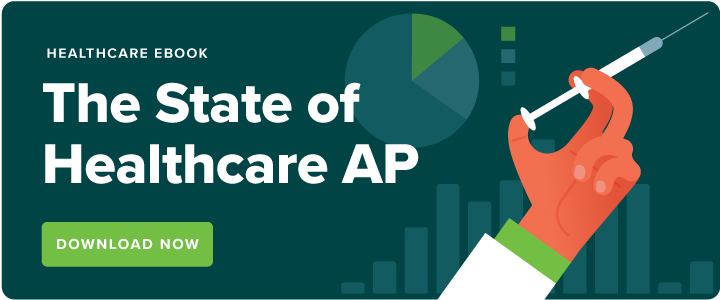Despite the incredible medical and technological advances that have led to the development of COVID-19 vaccines, among other achievements, healthcare is lagging behind other industries when it comes to automating back office operations like Accounts Payable (AP) and Finance. Surprisingly, an estimated 85% of AP departments are still bogged down with paper-based, manual processes, and that’s a big problem for an industry that is struggling to keep costs down in order to manage tight margins.
Automating healthcare accounts payable operations has largely been ignored, as health systems opt to focus on digitizing patient records and other initiatives instead. While manual processing has been an ongoing problem, the pandemic has uncovered just how difficult it is for healthcare accounts payable teams to process paper invoices manually, and to pay suppliers with checks, when many employees must work remotely.
Four Reasons to Shift from Manual Accounts Payable to AP Automation
In short, running AP processes manually can be a nightmare, and here are four reasons why:
- Finding invoices can become a game of hide and seek. Accounts payable departments are typically inundated with hundreds or even thousands of paper invoices each month, and staff may not be aware of them all. In many healthcare organizations, invoice receipt is decentralized, and invoices are received by different people in different locations. This means that it is near impossible for the AP department to know which invoices have come in, to locate where they are, and to round them all up without error. When invoice processing is automated, this problem goes away. All paper invoices can be sent to a dedicated email address that triggers an automatic invoice capture process or, if needed, to a post office box where it can be scanned and then sent to the AP system for capture.
- The process is time-consuming. It can take a couple of weeks to manually process an invoice. In addition to the time it takes to receive an invoice by mail and manually key in the data to the ERP, it has to be routed around the organization for approvals. While data entry is time-consuming in any organization, it’s particularly so in healthcare facilities, which commonly receive multi-page invoices with lines and lines of medical supplies and other goods. This inefficient process not only wastes time for the accounts payable department, but also for the approvers, which include doctors and other healthcare practitioners who are primarily focused on patient care. Some reviewers may need to compare an invoice with past ones to ensure the amount is consistent with previous purchases. Because everything is paper based, this involves digging through files to find them.However, once the process is automated, invoices are efficiently routed around to the appropriate people in accordance with the approval hierarchy. The system can assign reviewers by department, invoice amount, or other criteria. Since invoices are digitized, reviewers can easily see previous invoices to compare to those they need to approve.
- It can lead to late fees. Because it’s so time-consuming to receive and process invoices manually, it often precludes the opportunity for early payment discounts. Not only does AP miss out on these potential savings, but it is also often hit with late fees due to payment delays. Automation, by contrast, manages the AP workflow and deadlines so early payment discounts can be considered and late fees can become a thing of the past.
- It increases the potential for fraud. In 2019, 81% of companies experienced actual or attempted fraud, according to the Association for Payments Professionals’ (AFP) 2020 Payments Fraud and Control Survey. While invoices are particularly vulnerable to fraud, automated systems help organizations more easily spot these fraud attempts. Some capabilities that help with this include: two-factor authentication, which limits system access to approved personnel only; segregation of duties, which assigns invoice processing and payment authorization to different people; automated notifications of potential fraudulent activity, such as changes to a supplier’s bank information or address; and a log of payment activity.
Checks Compound the Problem, Virtual Cards Provide the Solution
Unfortunately, the challenges don’t end with manual invoice processing – the manual payments process is also fraught with delays and added costs. According to a Visa and Barlow Research study, a whopping 97% of mid-market companies in the U.S. use checks as a B2B payment method, and every time they write one, they are losing money. It costs about $5-6 for organizations to issue a check, factoring in the cost per invoice for paper stock, toner, ink, and the staff time needed to prepare it. This time-intensive process involves getting the check stock, printing the check, routing it for signatures, and mailing it.
Virtual cards provide a very efficient and cost-effective alternative to checks and can even turn the AP cost center into a profit center. Organizations earn cash-back rebates with each virtual card payment, and many companies’ rebates actually exceed the cost of their AP automation solution. Since solutions providers manage the payment process, including contacting suppliers about accepting virtual cards, it reduces the AP workload as well as the associated employee time and costs that could be better used for re-negotiating supplier contracts, researching and implementing new processes to support the business, analyzing spend to identify cost-saving opportunities, and other high-value activities. This is important when you consider that a manual process doesn’t make good use of the skill set or salaries of accounts payable team, who are typically college educated and can offer greater value to the organization.
There is another concern that healthcare organizations face with checks: they are the leading method associated with fraud, according to the 2020 AFP Payments Fraud and Control Survey. That is a major issue, considering that organizations globally lose 5% of their revenue annually due to fraud. By contrast, only 3% of organizations in the survey reported actual or attempted B2B payment fraud with virtual cards. That’s because of the protections virtual cards offer with unique, randomly generated numbers, limited to a specific payment amount and one-time usage.
With cost pressures and thin margins, healthcare providers can’t afford to lose money in their purchase-to-pay operations or to turn away opportunities to make money through early payment discounts and virtual card rebates. The healthcare industry has proven its success in applying technology to medical breakthroughs. Now is the time to bring those capabilities to the AP department, so healthcare organizations can realize savings – and even benefit from a new source of revenue – to operate profitably and be able to further invest in patient care and medical discoveries.




